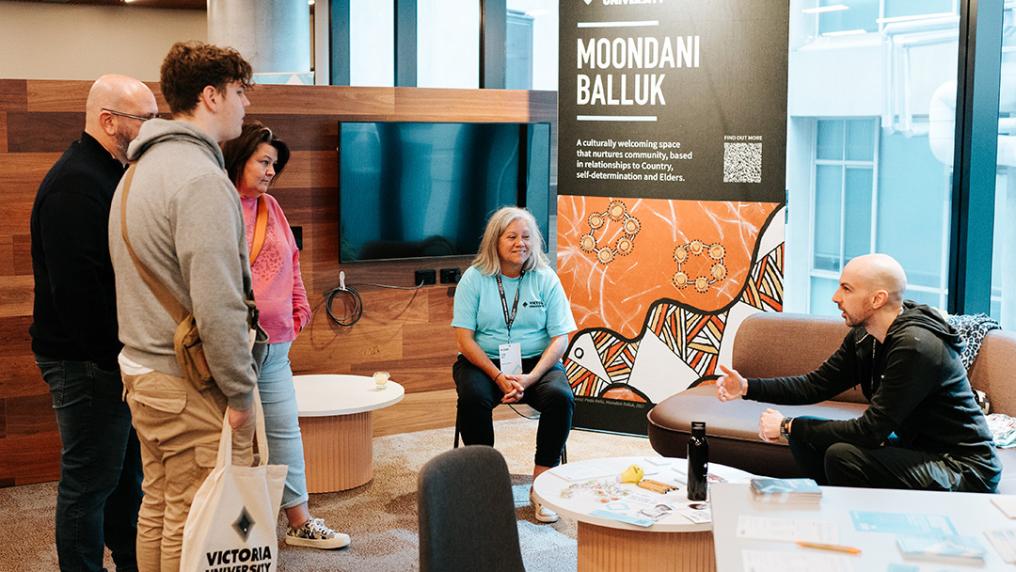Apply for undergraduate courses
Start the journey to a rewarding career with an undergraduate degree from VU. Find information for domestic students on how to apply for a bachelor degree, diploma or undergraduate certificate at Victoria University.
Choose the right information for you
-
Find out how to apply for a bachelor degree, diploma or undergraduate certificate as a Year 12 student.
The Victoria Tertiary Admissions Centre (VTAC), an independent admissions service for Victorian tertiary applications, will manage your application.
1. Choose your course(s)
Browse our study areas to find courses that match your interests and career goals.
On the course pages, you will find information about the subjects you will study, the practical experience in the curriculum and potential career paths.
Compile a list of your favourites, and make note of any courses listed as ‘pathways’ – these give you an alternative way to get into the course if your first preference isn’t successful.
2. Check entry requirements
On the course page(s) you're interested in, go to the 'entry requirements' section, where you'll see ATAR requirements if there are any.
Open the category ‘applicants with recent secondary education (within the last 2 years)’, where you'll find information such as the VCE subject scores needed to apply.
Check for any other requirements that are relevant to all applicants. 'Additional information' lists items that are not part of the admission criteria but will still need to be met while studying.
Confirm your eligibility for the course, and make a list of anything needed to apply.
If you don't meet entry requirements, check for any 'pathways', which offer a different way into the course.
3. Consider special admissions
You may receive adjustments to your ATAR selection rank through a successful application to VTAC's Special Entry Access Scheme (SEAS).
The scheme is used to consider difficulties you have faced that may have affected your exam results. It also helps under-represented groups, including Indigenous Australians, refugees, people applying to a field dominated by a different gender, and 'first in family' to attend uni.
You can apply for as many SEAS categories as are relevant to you:
- personal information and location (regional/remote)
- disadvantaged financial background
- disability or medical condition
- difficult circumstances.
VTAC considers some criteria automatically, such as under-represented schools, but evidence will be needed for other categories.
Find out more about SEAS and special admissions
4. Explore scholarships
We know how important it is to have financial security while you're studying. Our range of scholarships can help take the pressure off.
Some scholarships applications are made via VTAC; these are listed on the VTAC website. Other scholarships applications are made directly to VU, or the partner organisation offering the scholarship.
5. Consider our Early Entry program
Our VU Early Entry program ensures you have a conditional offer to study with us, before your exams. If you don't get the required exam results for your first choice, we'll find you an alternative course at VU. You'll also get 5 bonus ATAR adjustment points for some courses, and tailored support.
To be considered, you need to apply for the Early Entry program, and to list a VU course as your first preference in VTAC.
Discover our Early Entry program
6. Prepare your application
When applying through VTAC, you don’t need to provide evidence of your Year 12 exam results or ATAR score, as they have that information.
You will need to prepare:
- a unique student identifier (USI)
- student ID number
- passport/visa number if relevant
- evidence for special admissions (SEAS) if relevant
- supporting information for scholarship applications if relevant
- selection tasks listed on the course page, such as folio, audition, interview, supplementary forms, referee reports.
7. Apply via VTAC
Set up a VTAC account with your personal details and USI. You will be issued with an ID number and PIN so you can return to complete your application.
When you are ready to apply, log in and complete your education history. You can then enter up to eight courses you are interested in studying – starting with your top choice, then listing alternatives and pathway courses that will help you transition into your first preference.
In the same VTAC application portal, you can also apply for SEAS and some scholarships. Submit your documents early so you don’t miss out.
When you're finished, review your choices, pay the VTAC application fee and submit!
You can change your course list after submitting, during 'change of preference' times. Your VTAC account will list any offers, and we'll be in touch with an offer letter once you're accepted.
After you apply
Get support with your application & enrolment
VUHQ student service centre is your first point of contact for all students enquiries, before enrolling.
How we assess applications
Applications are assessed against the entry requirements outlined on each course page. As well as study prerequisites, you'll find English-language requirements for each course. Some courses have additional assessments, such as auditions or folios.
We will also consider your personal circumstances, as outlined in your special admissions application.






